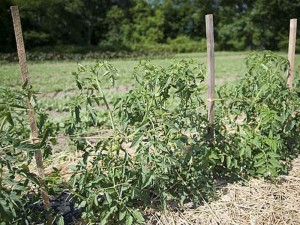Whether you transplanted seedlings and sowed seeds in May or are going to do so soon, the busy and fulfilling months of summer gardening are ahead of you.
Water regularly
New transplants need routine watering to ensure establishment and healthy growing.
Columnist Ivory Harlow explains that vegetable plants need 1 inch of water each week, depending on soil consistency, weather and a few other factors. Pay attention to your plants to learn their needs.
Apply mulch to vegetable and flower beds
Mulch helps to maintain the soil’s temperature and regulate temperature. It also protects plants from diseases and control weeds.
Related: July’s gardening to-do list
There are various types of mulch that can be used for lawns and gardens, including wood chips and bark, newspaper and straw.
Stake or cage plants
Once your tomato plants begin to bloom, tie the stalks to the stakes. Ohio State University Extension explains how to stake and cage tomato plants. University of Missouri Extension explains how to stake peppers.
Weed frequently
Instead of waiting until weeds are overtaking your garden, weed frequently to cut down on the overwhelming amount of work. University of Illinois Extension offers some tips for weeding.
Check out the insects in your garden
While beneficial insects can be found in the garden, there are other insects that can destroy an entire crop of vegetables in one season. Some beneficial garden insects include ladybugs, ground beetles and spiders. Some harmful insects include cutworms, aphids and Japanese beetles.
Insecticidal soaps, as explained by Penn State University Extension, are one approach to controlling insects in the garden. Insecticidal soaps wash away insects’ protective coating and then breaks away the insects’ cell membrane, killing the cell. Insecticidal soaps are normally useful for aphids, spider mites, thrips, whiteflies and mealybugs.
Watch for signs of pest damage
As your garden begins to grow, keep an eye on individual plants for signs of wildlife damage, such as torn leaves and stems or eaten vegetables.
There are various preventative measures that you can take to keep animals and insects away from your growing vegetables and flower beds. However, bugs, birds, chipmunks, groundhogs, rabbits and other wildlife may still disturb your garden.
To ward off birds, there are multiple strategies that you can try. Plastic netting, cheesecloth or even Bird-X Netting can be used to protect berries, fruit trees and gardens. Chemicals, Mylar streamers and even fishing line can be used to deter birds from feeding on your fruits and vegetables.
To protect your garden from wildlife like groundhogs, rabbits, chipmunks and deer, a number of strategies can be employed to protect your garden. Fencing is one good option for small critters, as long as the fence is buried a few inches in the ground and extends to a few feet above ground. If deer are a problem in your area, a taller fence will be needed. Other wildlife control method include repellents, plant cages and traps.
More about gardening:
- 10 tips to grow a container garden May 29, 2015
- Water your vegetable garden for optimal performance May 22, 2015
- How to plant a square foot garden May 7, 2015
- How should I arrange the plants in my garden? A guide to companion planting April 27, 2015
- If weeds could talk April 24, 2015
- 5 tips for creating a pet-friendly garden March 24, 2015













